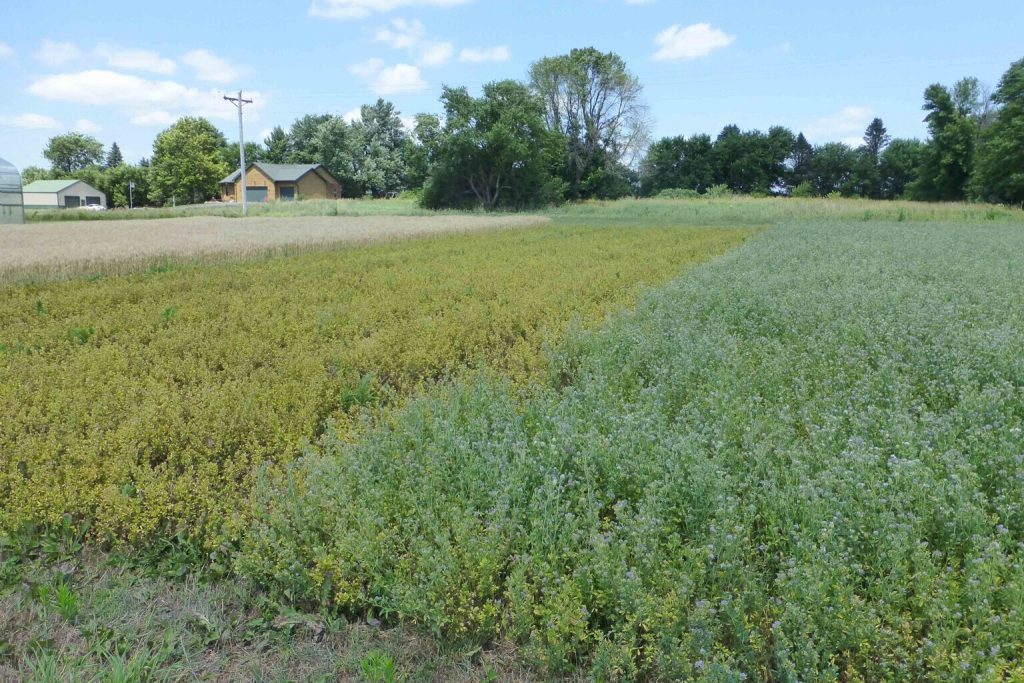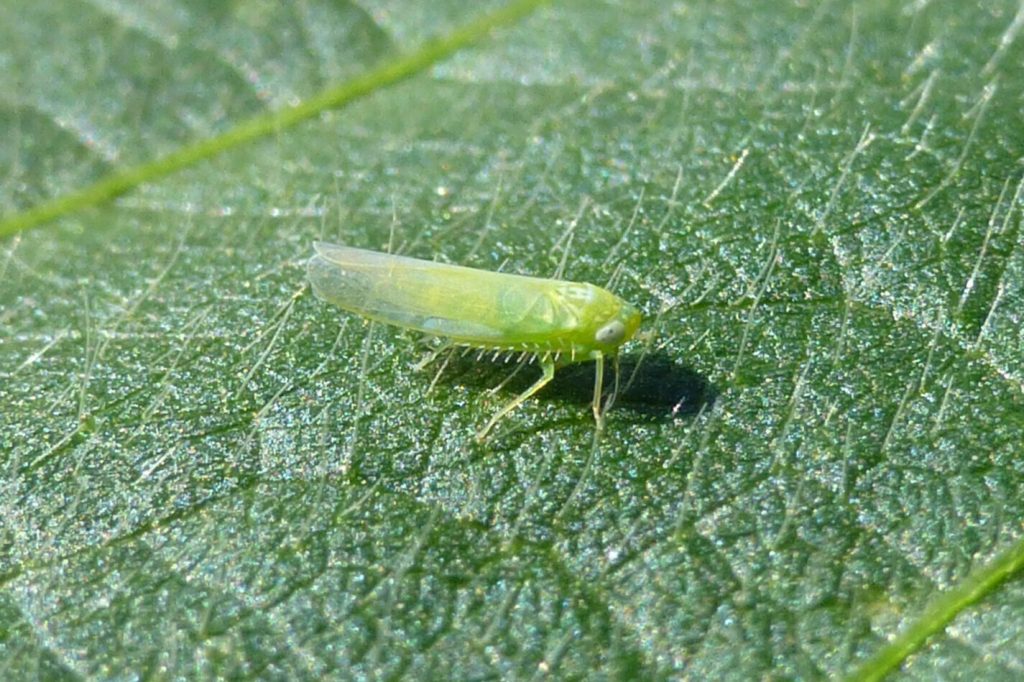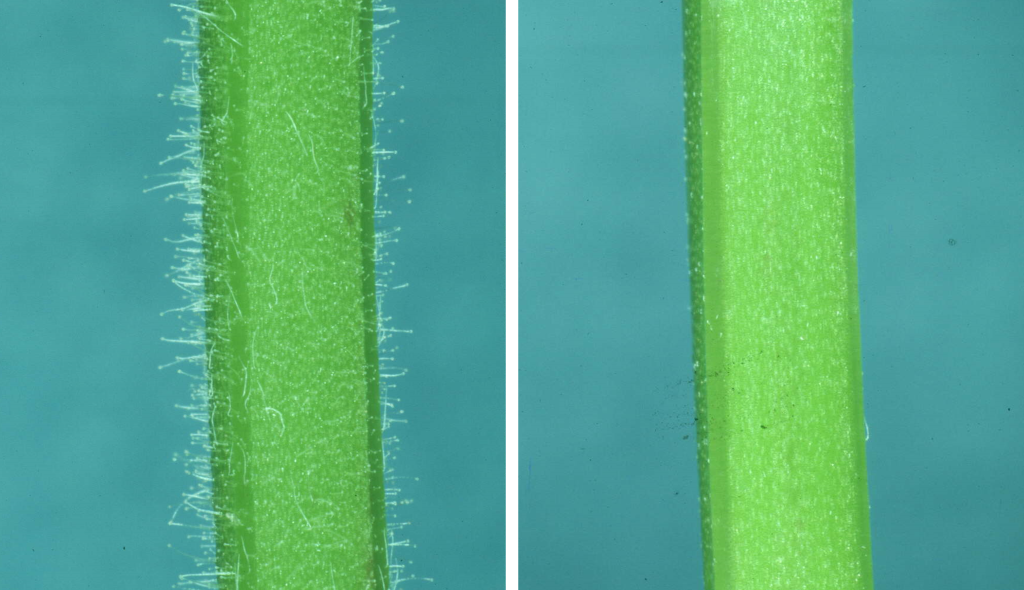Forage
Alfalfa NPGS Germplasm – Leafhopper Resistance
POTATO LEAFHOPPER RESISTANCE IN ALFALFA ORIGINATING FROM NPGS CROP WILD RELATIVE GERMPLASM INCREASES FORAGE YIELD AND QUALITY WHILE REDUCING PESTICIDE USAGE
Brian M. Irish; E. Charles Brummer; and Deborah Samac
USDA-ARS Temperate-adapted Forage Legumes, 24106 N Bunn Rd, Prosser, Washington 99350.
Center for Plant Breeding, University of California, Davis, 1234 PES, One Shields Avenue, Davis, California 95616.
USDA-ARS Plant Science Research Unit, 495 Borlaug Hall, 1991 Upper Buford Circle, St. Paul, Minnesota 55108.
Corresponding author: brian.irish@usda.gov
OUTLINE
1. SUMMARY

Potato leafhopper (PLH; Empoasca fabae), one of the most economically devastating pests of alfalfa in the eastern half of the United States and Canada, causes seedling mortality, adult plant stunting, and significantly reduced forage yield and quality. In the 1980s, a glandular haired (trichome) trait conferring resistance to PLH was discovered in USDA-ARS National Plant Germplasm System (NPGS) alfalfa and crop wild relative accessions from the Prosser, Washington genebank unit. This trait was introgressed into elite breeding lines resulting in PLH resistant cultivars.
The goal was to produce alfalfa cultivars with potato leafhopper resistance, leading to more economically and environmentally sustainable forage production.
Download a printable fact sheet by clicking the image below.
2. PROBLEMS ADDRESSED

PLH feeding on alfalfa causes “hopperburn,” the yellowing of foliage and stunting of plants (Sulc et al., 2001; Lamp, 2016). The damage causes reduced yield and quality in the alfalfa crop during mid-summer cuttings, and if severe, to subsequent crop harvests; this leads to significant economic losses for U.S. producers. Prior to the 1980s, there were no cultivars with resistance to PLH and the pest was often managed by early harvest of the herbage, leading to reduced realized yield potential. Insecticides can also manage PLH but require regular scouting to determine economic thresholds and come with economic costs as well as environmental and safety hazards.
3. SOLUTIONS DEVELOPED

The PLH resistance glandular trichome trait was identified in wild relatives of cultivated alfalfa from the NPGS unit in Prosser, Washington during screening of germplasm for disease and insect pest resistance. PLH resistance was initially incorporated into alfalfa breeding lines in collaborative efforts between USDA-ARS and Kansas State University scientists and by Purdue University researchers (Sorensen et al., 1985; 1986, Shade and Kitch, 1986). Resistance mechanisms are not entirely understood, but likely involve a combination of factors including non-preference, tolerance, mortality (antibiosis), and decreased feeding (antixenonis) (Elden and McCaslin 1997; Shockley et al., 2002). Early breeding lines were subsequently used to develop modern commercial cultivars by introgressing the trait into elite commercial germplasm with improved agronomic performance (McCaslin, 2000). Many commercial cultivars grown in the mid-western U.S., where potato leafhopper is a significant problem, have incorporated the PLH resistant trait along with other insect and disease resistances (Sulc et al., 2001). The adoption by U.S. producers where leafhoppers occur has led to stability in alfalfa yield and forage quality combined with sustainable insect management.
Collaborators initially involved in developing PLH resistant cultivars:
- Edgar L. Sorensen, USDA-Agricultural Research Service, Manhattan, Kansas, USA
- Daniel Z. Skinner, USDA-Agricultural Research Service, Pullman, Washington, USA
- Ernst K. Horber and Donald L. Stuteville, Kansas State University, Manhattan, Kansas, USA
- Richard E. Shade and Laurie W. Kitch, Purdue University, West Lafayette, Indiana, USA
Current alfalfa breeding companies with significant roles in developing and/or marketing PLH resistant cultivars:
- Forage Genetics International, Nampa, Idaho, USA—U.S. utility patent #6,127,599 for alfalfa leafhopper resistance was awarded to M. McCaslin of Forage Genetics International in October 2000 (McCaslin, 2000)
- DLF Seeds (formerly Alforex Seeds), Roskilde, Denmark
- S&W Seed Company, Longmont Colorado, USA
- Legacy Seeds, Scandinavia, Wisconsin, USA
4. IMPACT
Growing leafhopper resistant alfalfa cultivars, especially when pest pressure is high, is an environmentally friendly tool. This tool increases safety by reducing or eliminating the need for insecticide use while reducing crop production costs. Under insect pest pressure and when insecticides are not applied, resistant cultivars have helped producers maintain forage yields and quality, increasing profitability, particularly for organic growers. Although difficult to quantify precisely, a significant acreage of PLH resistant cultivars with the glandular-haired trait is grown in the U.S. where the insect pest occurs. In addition, new cultivars with the glandular-haired PLH resistant trait are released by major breeding companies every year. These cultivars are described in the Association of Official Seed Certifying Agencies (AOSCA) Alfalfa and Miscellaneous Legumes Variety Review Board yearly publications and the National Alfalfa and Forage Alliance (NAFA) Alfalfa Variety Ratings.
5. GERMPLASM
Alfalfa cultivars and their crop wild relatives from the NPGS unit in Prosser, Washington were used to breed economically viable cultivars with resistance to PLH. Some early breeding successes are described below:
KS108GH5. This germplasm is maintained by the NPGS as NSL 195550. It was derived from PI 346919 (Medicago sativa L. subsp. sativa from Russia) by five cycles of recurrent phenotypic selection for erect glandular hairs on the seed pods and vegetative organs (Sorensen et al., 1985).
KS94GH6. This germplasm is maintained by the NPGS as NSL 202090. It was derived from diploid (2n=2x=16) Medicago glandulosa (now Medicago sativa L. subsp. falcata (L.) Arcang. var. viscosa (Rchb.) Posp), an M. sativa subsp. falcata type with erect glandular hairs, by six cycles of recurrent phenotypic selection for increased hair density and distribution (Sorensen et al., 1986).
KS224. This germplasm is maintained by the NPGS as PI 572543. It was derived by intermating F1 plants from a cross of diploid (2n=2x=16) Medicago glandulosa and M. prostrata with KS219, a multiple pest-resistant M. sativa (2n=4x=32)(Sorensen et al., 1994).
81IND-2. This germplasm is maintained by the NPGS as NSL 182180. It is a synthetic population derived from three perennial Medicago species: cultivated M. sativa, and wild relatives M. prostrata and M. glandulos (Shade and Kitch, 1986).
6. REFERENCES
Elden TC, McCaslin M. 1997. Potato Leafhopper (Homoptera: Cicadellidae) Resistance in Perennial Glandular-Haired Alfalfa Clones. Journal of Economic Entomology 90:842-847. https://doi.org/10.1093/jee/90.3.842
McCaslin MH. 2000. Potato Leafhopper Resistant Alfalfa. (U.S. Patent No. 6,127,599). U.S. Patent and Trademark Office. https://patents.google.com/patent/US6127599
Lamp WO. 2016. Potato leafhopper. In: Samac DA, Rhodes LH, Lamp WO (Eds.) Compendium of Alfalfa Diseases and Pests, Third edition. APS Press, St. Paul, Minnesota.
Shade RE, Kitch LW. 1986. Registration of 81IND-2 Glandular-Haired Alfalfa Germplasm. Crop Science 26:205. https://doi.org/10.2135/cropsci1986.0011183X002600010064x
Shockley FW, Backus EA, Ellersieck MR, Johnson DW, McCaslin M. 2002. Glandular-Haired Alfalfa Resistance to Potato Leafhopper (Homoptera: Cicadellidae) and Hopperburn: Development of Resistance Indices. Journal of Economic Entomology 95:437-447. https://doi.org/10.1603/0022-0493-95.2.437
Sorensen EL, Horber EK, Stuteville DL. 1985. Registration of KS108GH5 glandular-haired alfalfa germplasm with multiple pest resistance. Crop Science 25:1132. https://doi.org/10.2135/cropsci1985.0011183X002500060072x
Sorensen EL, Horber EK, Stuteville DL. 1986. Registration of KS94GH6 glandular-haired alfalfa germplasm with multiple pest resistance. Crop Science 26:1088. https://doi.org/10.2135/cropsci1986.0011183X002600050066x
Sorensen EL, Stuteville DL, Horber EK, Skinner DZ. 1994. Registration of KS224 glandular-haired alfalfa germplasm with multiple pest resistance. Crop Science 34:544. https://doi.org/10.2135/cropsci1994.0011183X003400020059x
Sulc RM, van Santen E, Johnson KD, Sheaffer CC, Undersander DJ, Bledsoe LW, Hogg DB, Willson HR. 2001. Glandular-Haired Cultivars Reduce Potato Leafhopper Damage in Alfalfa. Agronomy Journal 93:1287-1296. https://doi.org/10.2134/agronj2001.1287
7. CHAPTER INFORMATION
Citation: Irish BM, Brummer EC, Samac DA. 2024. Alfalfa NPGS Germplasm – Leafhopper Resistance. In: Volk GM, Chen K, Byrne P (Eds.) Plant Genetic Resources: Success Stories. Fort Collins, Colorado: Colorado State University. Date accessed. Available from https://colostate.pressbooks.pub/pgrsuccessstories/chapter/alfalfa-npgs-germplasm-leafhopper-resistance/
Content originally submitted: February 11, 2024
Date of publication: May 20, 2024
USDA is an equal opportunity provider, employer, and lender. Mention of trade names or commercial products in this article is solely for the purpose of providing specific information and does not imply recommendation or endorsement by the U.S. Department of Agriculture.


